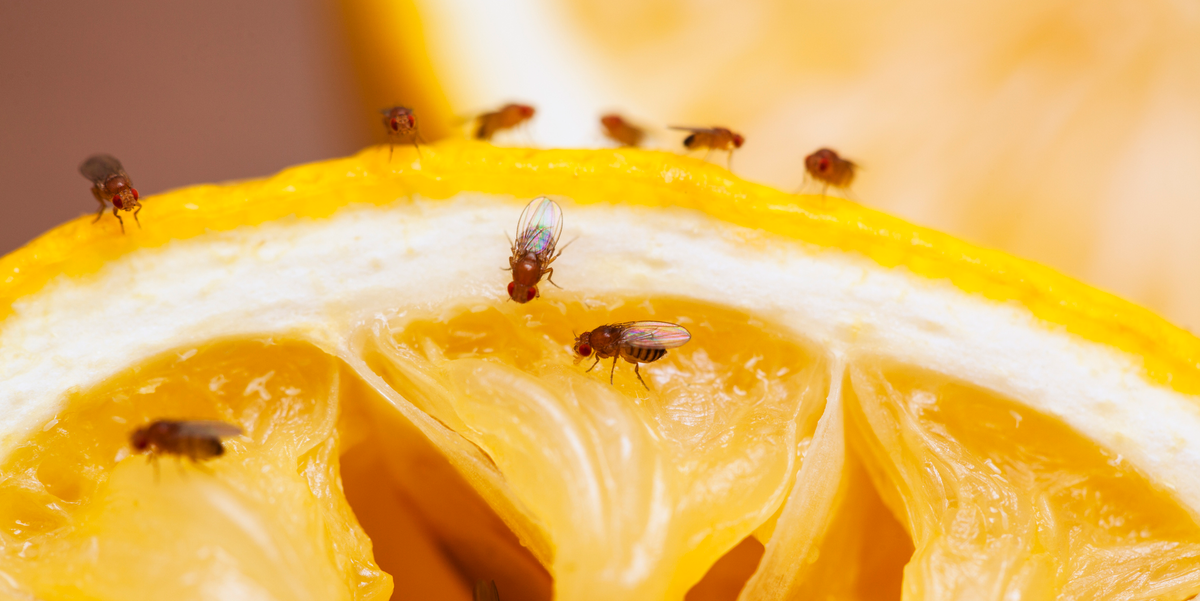By Steve Racioppe M.S.

Fruit flies are in the genus Drosophila. There are several species that cause problems in structural settings. The most common are melanogaster and repleta. Melanogaster is easily identified by their bright orange/ red eyes, whereas repleta (dark-eyed fruit fly) typically has black eyes. Fruit flies can be a difficult pest because they are frequently brought in with produce and have a very fast reproductive cycle. Once introduced they can get out of hand quickly. Not only are they a nuisance but they can transmit bacteria mechanically by flying from a contaminated surface to a food surface.
Fruit flies are small- about 1/8” in size and yellow-brown in color with a stout body. The female lays eggs in small clusters in decaying/fermenting organic matter. They are particularly fond of rotting fruit and sugary fluids. She will lay hundreds of eggs over several days. Like other flies in the order Diptera they have complete metamorphosis, so eggs hatch into larvae or maggots after just 12-24 hours. The larvae will live in the source material, such as rotting fruit, for 3 or 4 days before crawling to a dry area to pupate. The fly will develop and emerge from the pupal casing in 1 to 2 days. Once emerged, the adult fly is sexually mature in about a day. So under ideal conditions fruit flies can complete an entire life cycle in about 7 days.
It seems cliché, but the solution to fruit flies is eliminating the source. If you’ve looked everywhere and can’t find the source, look some more. Without finding the source the infestation will continue in perpetuity or until the breeding source is depleted. Until then you’ll be reduced to trapping and fogging which is expensive and leaves your client dissatisfied. Bananas are a common source as they aren’t normally refrigerated and are often left sitting out. Don’t overlook things like an onion nestled deep under the stove, empty soda cans in the recycle bin, or an old juice spill under a counter. Accumulated food material in cracks in the flooring or in the wall/floor juncture are also potential breeding sites. Any type of organic matter should be identified and eliminated. But wait, that’s not all! They’ll also breed in slime that accumulates around drains or in broken tiles. If it’s organic and decomposing a fruit fly can breed in it.
OK, we’ve already suggested that you eliminate the source, but what can you do while you’re looking, and what steps can you do to reduce decaying organic matter? For one thing make sure you document! You will ask the staff to clean and they probably won’t do it- at least not adequately. Without specific documentation of the things you’ve asked the staff to clean you will have little defense when called to account. Write a thorough sanitation report. Take pictures of items that need cleaned and removed. Document poor cultural practices, such as improper storage of mops (yes, they’ll breed in mops, too) or poor garbage handling.
Other than cleaning and proper storage, the next best way to reduce organic debris is to use bacterial organic reduction materials like BioGel from Pest West, or Vector Bio 5 for example. You can also get aerosol versions for drains such a Foam Fresh by Nisus or Invade Bio Foam from Rockwell Labs. These materials can be applied directly to the organic matter in question. You can also use them directly into drains. If you need to apply with a sprayer, they typically have instructions for mixing with water as well. This process can take days/ weeks, however. So let’s look at adult population reduction.
There are several commercially available traps that use a fruit-based fluid to attract the flies. Once lured into the trap they contact the fluid and drown. These can be useful around a bar or any discreet area near high fly activity. Some commonly used examples are BASF’s Vector 960 Fruit Fly Trap and Natural Catch. Another type of trap that can be useful are ILT’s. Fruit flies are somewhat attracted to UV light, so placing lights in the kitchen or behind the bar where you’re seeing activity can be helpful. There are lots of light traps on the market, but choose one by a good manufacturer as the quality from lesser manufacturers can be spotty. A great light for small areas, such as behind the bar top, is Vector Plasma One from Catchmaster. It is a sanitary trap using glue boards to capture the flies and its’ combination of size and quality is a great value for small areas. But two bulb lights by Pest West, Catchmaster (Vector line), and others work well for larger areas. Change bulbs at least once per year as bulb efficacy decreases over time.
Trapping helps, but is rather slow and inconsistent. The use of commercial fans for temporary relief while you do the necessary detective work to find the breeding material can also be a useful tool. Fruit flies are weak fliers and don’t normally alight with air flow.
Knocking flies down quickly involves fogging. Products like the B&G PAS Commercial unit or an Actisol machine work very well. Typically a .5% to 1% pyrethrin product is used through the machine. For smaller areas you can also use an aerosol, such as PT 565 Plus XLO from BASF or CB80 from FMC. Be sure to use a fogging tip when doing this type of application. Also, wear a respirator and check additional label and PPE requirements.
Understand that treatment methods other than source elimination will be just a band aid. Ultimately, the only solution is to eliminate the source. Ask anyone who’s been in the business for a while about the craziest fruit fly source they found. You’ll hear some funny stories! Happy hunting.
Steve Racioppe, M.S.
Steve Racioppe is General Manager and staff entomologist for Geotech Supply. He earned his undergraduate and master’s degree in fly biology from Rutgers University. He spent time as a technical director for a large firm in Texas, was Sales Director for Whitmire Micro-Gen and BASF, and has been G.M. for Geotech Supply since 2012. For questions or identifications contact Steve at sracioppe@geotechsupply.com.

 If you’d like a free copy of PCT’s Structure Infesting Flies guide*, email jwoodward@geotechsupply.com.
If you’d like a free copy of PCT’s Structure Infesting Flies guide*, email jwoodward@geotechsupply.com.
*While supplies last
*One copy per company

